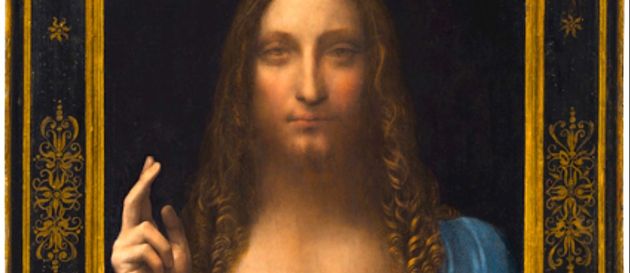Since the 9/11 attack in 2001, we have seen more than 60 new Muslim movements to Christ.
 Leonardo da Vinci’s Salvator Mundi (ca. 1500).
Leonardo da Vinci’s Salvator Mundi (ca. 1500).
The recent sale of Leonardo da Vinci’s Salvator Mundi (ca. 1500) for $450.3 million made world news as the highest purchase ever for a painting. Who had so much money to pay such a price for a painting that in 1958 was sold for a mere £45?
The latest twist in an improbable story was the revelation that Mohammed bin Salman, crown prince of Saudi Arabia, was the mystery buyer.
Considering that the prince’s staunchly Muslim country bans and persecutes Christianity, this is remarkable. Depictions of any religious figures are banned. But this particular depiction is not just of any religious figure.
For Da Vinci portrays Jesus of Nazareth as Saviour of the world and Master of the cosmos.
In his left hand he holds a transparent rock crystal orb, signifying the ‘crystalline sphere’ of the heavens, as perceived during the Renaissance. Jesus is the Redeemer of mankind; he is the Second Person of the Trinity.
That is blasphemy for Muslims who confess that ‘there is only one God, his name is Allah, and he has no son’.
First reports were that the buyer was a distant cousin of MBS (as the crown prince is commonly called), another Saudi prince named Bader bin Abdullah bin Mohammed bin Farhan al-Saud (presumably a.k.a. BBABMBFAS?). Apparently he was acting on behalf of the crown prince.
Officials have confirmed that the painting will be displayed in the newly-opened Louvre Abu Dhabi.
My son Philip recently created a video for the new gallery with the commission to illustrate ‘how we are all connected (all things and all people).
For example, one image could show a bible being opened, and the next image could be of the qur’an closing’.
Writing in the Mercatornet webzine on religion and spirituality in the public square, Czech political analyst Peter Kopa asks if the bold reforming spirit of MBS marks a moment for a rapprochement between Christianity and Islam in the Muslim Arab world.
Saudi Arabia is notorious for religious intolerance, he notes. All citizens must be Muslims; mosques are the only permitted places of religious worship; the legal system is based on the Quran and the Sunna.
And although this has not happened in recent times, blasphemy against Islam may legally be punished by death.
Yet things seem to be changing, he observes. Despite the strict religious atmosphere in the Saudi kingdom, enforced by the Commission for the Promotion of Virtue and Prevention of Vice, almost half of men under 35 defy the Koran’s directive to attend mosque on Fridays.
The project of opening a branch of the Louvre in the Arab world is not without risk. For a large proportion of the Louvre, as with collections of any western art gallery older than say two centuries, focusses on biblical scenarios. Where might this lead?
On the Greek island of Lesbos, I witnesssed another such ‘crack in the universe’ moment. On board the 42m ketch, s/v Next Wave, moored in the harbour of Mytilinis as an operations base for relief work in the nearby Moria holding camp, perhaps 100 crew, staff, Refuge DTS students and refugees were squeezed into every available seat and space on the floor waiting for the weekly community meeting to start.
The expectant buzz reminded me of the atmosphere 40 years ago in YWAM Amsterdam’s houseboat called The Ark. Instead of the hippies and world travellers waiting to head down the drug trail through the Middle East to Afghanistan, Nepal and India, half of those present were refugees from Afghanistan, the Middle East and Africa, mostly Muslims.
When the time came for me to address the gathering, a refugee volunteer unknown to me was thrust forward to translate into Arabic. Being on a boat, I spoke about hope, and its biblical symbol, the anchor.
I talked about the grounds and goals of our hope both being found in the Triune God, Father, Son and Holy Spirit. My translator faithfully followed my story.
Later he told me he was a Palestinian Muslim and that he had found it hard to translate my references to Jerusalem and Israel. Yet he made no objection to my references to the Trinity, blasphemous as they normally would be for Muslims.
It was remarkable that so many Muslims listened with respect, the result of the trust relationships built by staff and students.
Author Dr David Garrison would not be surprised. His book A Wind in the House of Islam argues that God is active today creating more Muslim movements to Isa (Jesus) than ever before. While the first two movements only appeared in the 19th century, a further ten emerged in the late 20th century.
Yet since the 9/11 attack in 2001, we have seen more than 60 new Muslim movements to Christ. The cracks seem to be widening. In Leonard Cohen’s words: ’That’s how the light comes in’.
Jeff Fountain is Director of the Schuman Centre for European Studies, and speaks on issues facing Christians today in Europe. He writes at Weekly Word.

Las opiniones vertidas por nuestros colaboradores se realizan a nivel personal, pudiendo coincidir o no con la postura de la dirección de Protestante Digital.
Si quieres comentar o